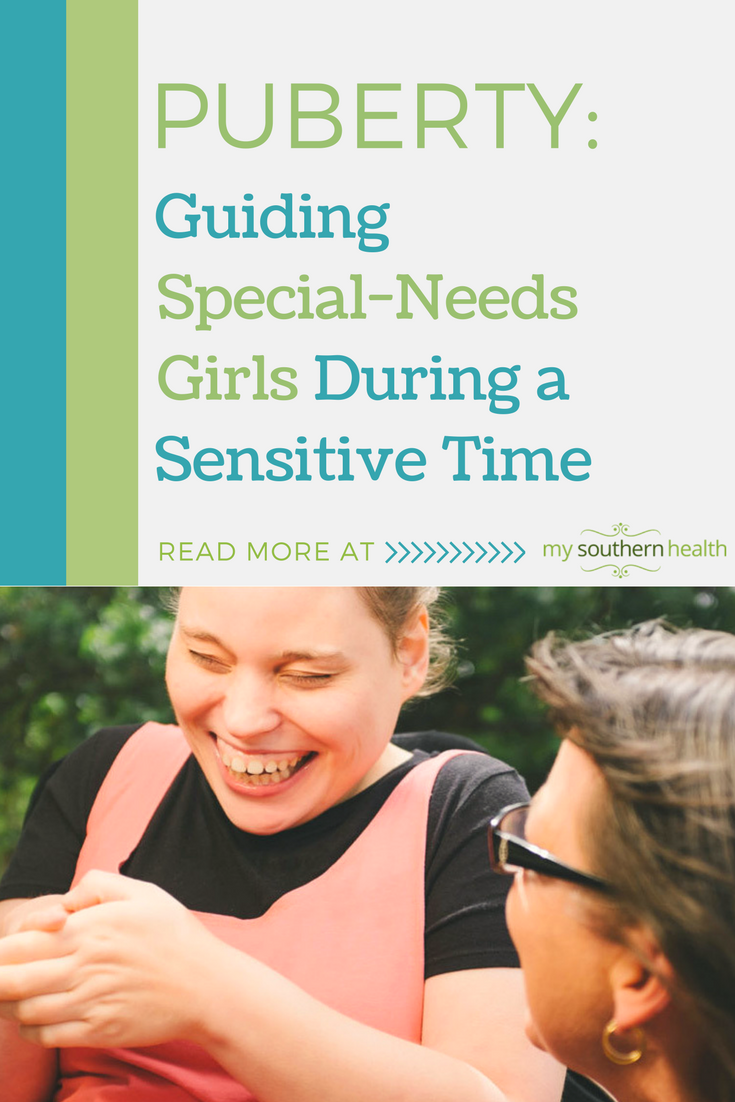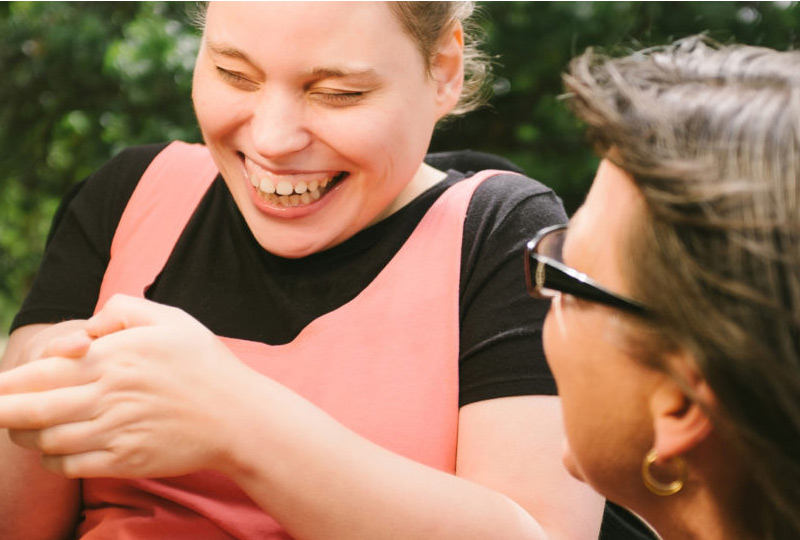Tips to help your daughter (and you) navigate this sensitive time.
Though special-needs children have developmental disabilities in some areas, they generally experience puberty at the same age as their peers – anywhere from age 9 (or possibly earlier) to 15.
Helping girls navigate puberty can be awkward regardless of the circumstances, but families raising special-needs kids have additional challenges. The Vanderbilt Kennedy Center, which supports people with disabilities and their families, publishes a guide, “Healthy Bodies for Girls,” with these tips for teaching your daughter (and you!) to handle puberty as gracefully as possible.
Don’t wait until your daughter hits puberty to talk to her about it. Start before the obvious signs are there. Changes in her body can be scary if she doesn’t understand what’s happening.
Find the right words
Make sure to use the correct words for body parts — vagina and breasts, for example — and bodily functions, such as urination and menstruation. This makes it easier to talk about everything from hygiene to reproduction.
Building up to a bra
Help your daughter get used to wearing something under her shirt by giving her training bras, camisoles, tank tops with thin straps or sports bras. Find ones that snap in front if she has trouble with dexterity, or ask her occupational therapist about adaptive bras.
Physical activity a priority
Schedule some time every day for your daughter to get some exercise. Join in to encourage her. If your daughter has motor impairments, ask her doctor or therapist for safe exercises she can do. There may be adapted activities in your area designed for teens with special needs.
Reward her for physical activity, but do not use food to encourage exercise.
Teaching hygiene
Good hygiene habits make your daughter more independent and confident. Let her help create hygiene “kits.” These can be assembled in baskets, shoe boxes, plastic containers – whatever she likes. Stock the kits with everything needed for certain tasks and label each kit for that task. For example, a shower kit might contain body wash or soap, shampoo and conditioner and a razor.
Explain menstruation long before it begins, so she isn’t frightened by discovering that she’s bleeding. Her period will probably start a year or two after she develops breast buds.
A menstruation kit can be especially helpful in preparing your daughter for her first period. Stock a kit with different sized pads, wet wipes, a change of underwear and pain reliever, if she can take medication on her own. Consider providing a kit for school to be kept in the nurse’s office or in another private place.
Show her how the pads adhere to her underwear. If your daughter needs help remembering how to use the pads, you can mark the inside of her underwear so she can see where to place the pad. Let her wear a thin pad as practice before her period begins. If your daughter has trouble remembering what to do, provide pictures of the step-by-step process for changing her pad.
Ramp up hair care. Teens need to wash their hair more frequently than younger children. The motor demands of this task might make shampooing challenging for your daughter, or she may not grasp that at this age, her classmates pay close attention to cleanliness. Create a schedule for how often she should wash her hair. Consider items that may make washing easier, such as using a sponge, pump bottles or a visor to keep the soap from her eyes.
Prevent body odor. Sweat glands become more active during puberty, so young teens need to learn to use deodorant, wear clean clothes and keep their bodies clean. Again, visual checklists can help your daughter take charge of these tasks. If applying deodorant is physically difficult, try different types, such as roll-ons or sprays. If she cannot bathe independently, try using bath seats, a removable showerhead, extended scrubbing handles or scrubbing gloves to make the task easier.
Keep clean teeth and clean breath. Create a visual schedule for when she should brush and floss her teeth. An electric toothbrush might be easier for her to manage than a plain manual one. Timers or songs can help her know how long to brush. (Dentists recommend two minutes.)
If your daughter wants to wear makeup, start with something subtle and simple to apply, such as tinted lotion, lip gloss or face powder.
Public vs. private
Explain to your daughter what parts of her body are “private parts.” A simple way to convey this is to describe them as parts that are covered by underwear or a swimsuit.
Kids with developmental delays may need help learning what behavior is acceptable in public and what should remain private. Talk to your daughter about things that should only be done in private, such as going to the bathroom, changing clothes, touching private parts, passing gas and more. When she does things such as adjusting her underwear or touching her private parts, redirect her to an appropriate place by telling her, “You can do that in your bedroom/bathroom.” Use pictures or visual supports to help her learn to distinguish private from public and to redirect her when she engages in private behaviors in public places.
Teach your daughter what’s appropriate to talk about in public and what’s not. For example, her period is private, something that’s OK to talk about only with parents, doctors or the school nurse – not with friends, teachers or strangers.
If your daughter needs help with private tasks, such as getting dressed or using the toilet, teach her how and who to ask for help when she is out in public, such as at a restaurant or at school. With her, think through how to plan ahead, ask discreetly for help, or make picture cards she can use to request help.
All kids touch their private parts sometimes. Shaming or punishing your daughter for doing it is likely to confuse her and make her less likely to ask you questions, and the attention might make her more likely to do it rather than less. Better to teach her to keep this behavior private. Use a visual signal to remind her of the rule (“no hands in pants”) or to shift her to some other action she can’t do at the same time, such as “hands on the table.” Be aware that kids may touch their private parts if they hurt or itch. If your daughter seems to be touching her private parts frequently, she could have an infection, irritated skin or some other problem that needs a doctor’s attention.
Puberty and moodiness
Puberty can create a lot of emotional ups and downs. Teach your daughter to express her feelings. If she is verbal, help her name her emotions (“It sounds like you’re angry”). If she is not verbal, use visual depictions of emotions she can show you to express her feelings.
Kids with disabilities are at higher risk than their peers for mental-health problems that require intervention. Signs that your daughter is experiencing anxiety, depression or perhaps even thyroid problems that mimic depression include increases in crying, shouting or laughing for no reason; compulsive behavior; aggression; troubled sleep; confusion; withdrawing from things she used to enjoy; and more. If you notice these changes, talk to her pediatrician about seeing a psychologist, behavioral specialist or psychiatrist for a consultation.
Teaching strategies
Children with disabilities will need more than just an explanatory chat to learn these skills and rules. Take your daughter’s learning style into account.
- Use visual checklists, visual supports and social stories when talking about bodies and puberty. Repetition often helps, so break information into small, simple facts and go over them frequently.
- Making a picture book might help when you’re teaching her how to take care of herself. Let her help create it. How many images you include and how simple or detailed you make it should vary according to her reading level and memory. Include pictures of supplies she needs: for example, soap, shampoo, deodorant, pads, etc. Create pictures that explain when she needs to perform certain hygiene tasks and what supplies she needs for each step.
- Laminate an image of a girl’s body to serve as a checklist for hygiene tasks. For example, a shower checklist can be in the form of a picture of a female body. Attach it to the shower with Velcro. List the steps for showering (shampoo, conditioner, etc.), with the steps marked on the right body part on the laminated image.
- If your daughter needs help understanding the difference between public and private places and behaviors, make a list of public places versus private ones, and what behaviors are appropriate where. Use pictures of places and behaviors instead of words for children who have communication delays. Help her select examples of behaviors that are appropriate for each setting.
- Create a schedule for how often she needs to do each task – for example, taking a bath or shower daily, brushing her teeth after each meal.
- To help her learn how long to stay in the shower or bath, a music playlist of songs that runs for the right amount of time can be a helpful cue. Each new song can signal when to move to the next step on the list.
- Use social stories. Think about situations and behaviors that are difficult for your daughter, and create a first-person story that explains the social rules for that situation and helps her understand what other people are thinking and feeling.

This article is based on a guide, “Healthy Bodies for Girls,” which the Vanderbilt Kennedy Center has available as a free download. The Kennedy Center also publishes a similar guide for boys. The guides contains all of these tips, many more, and a list of resources for families of children with disabilities.

